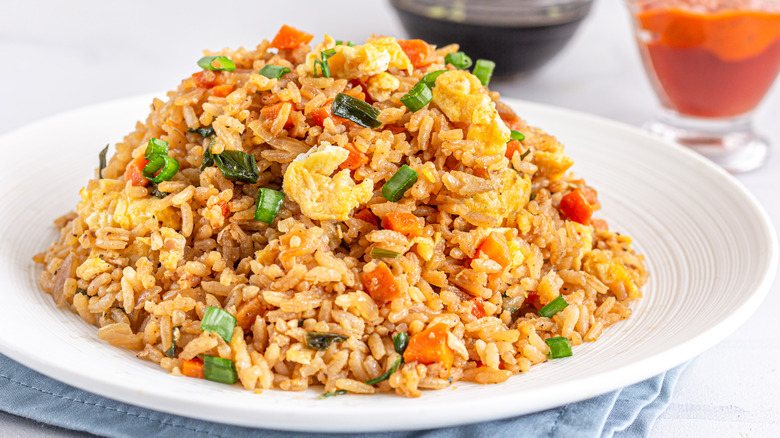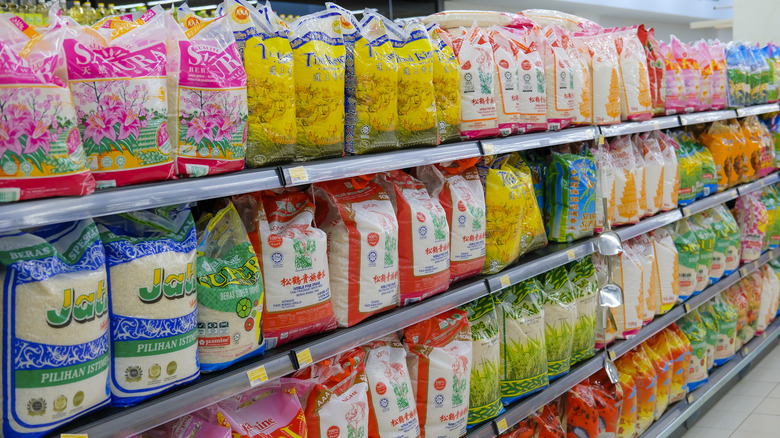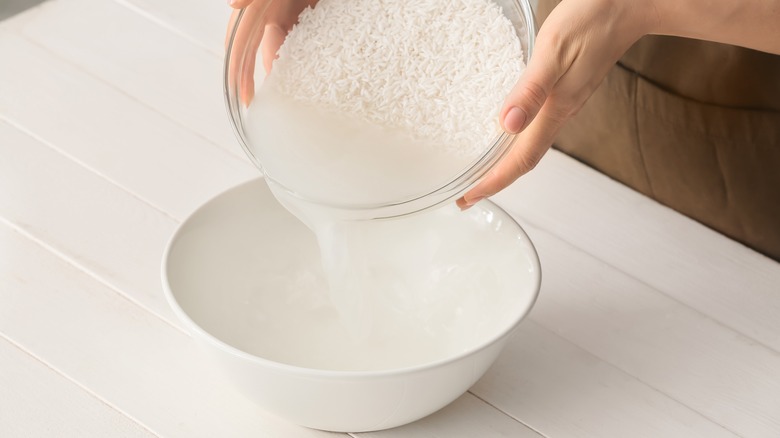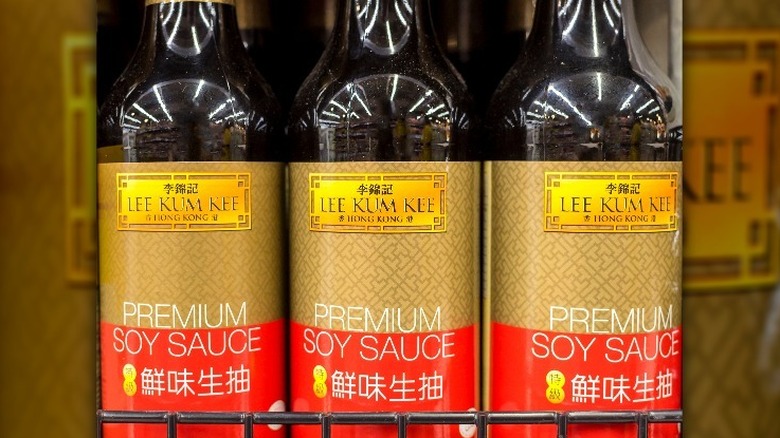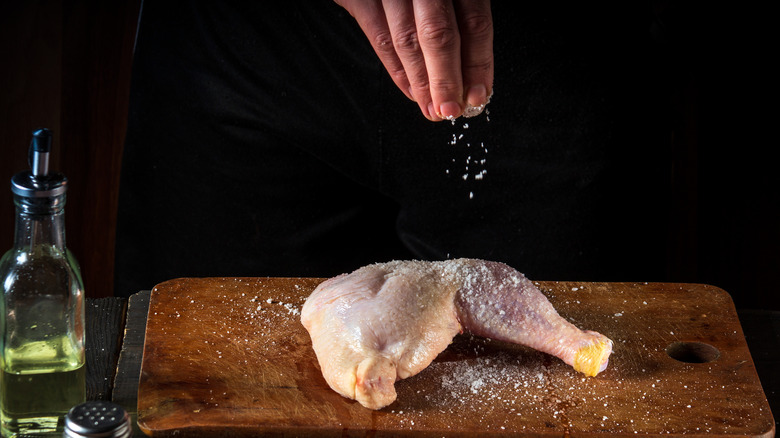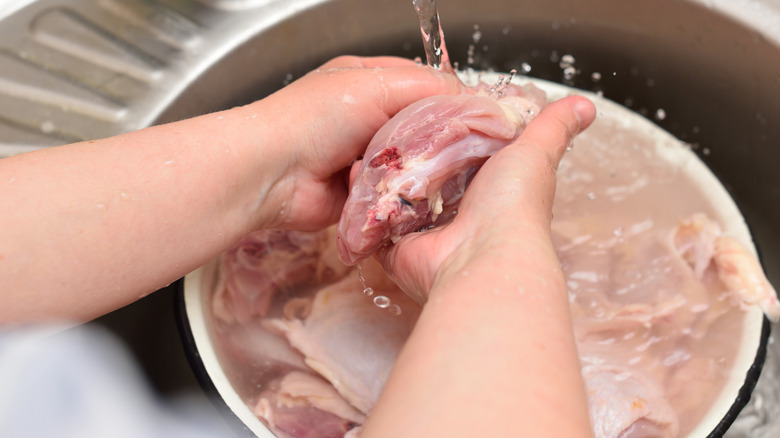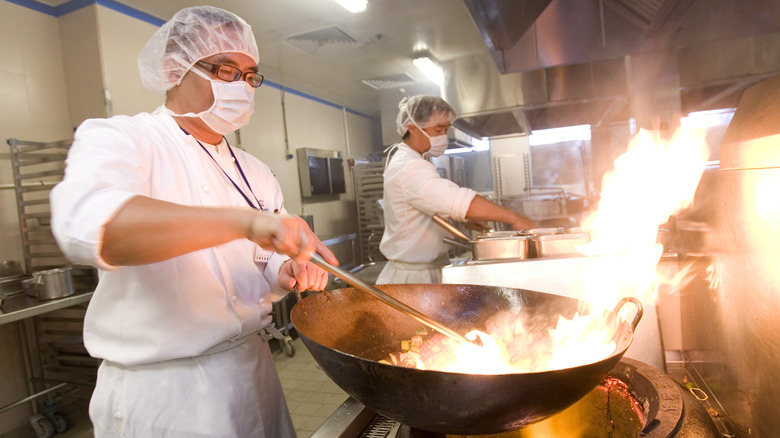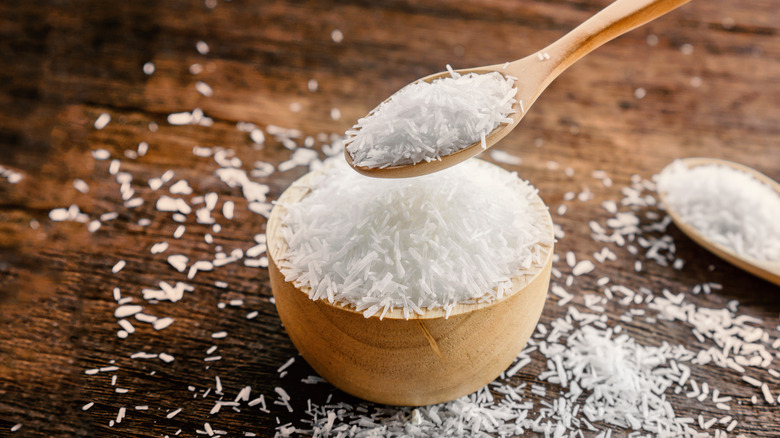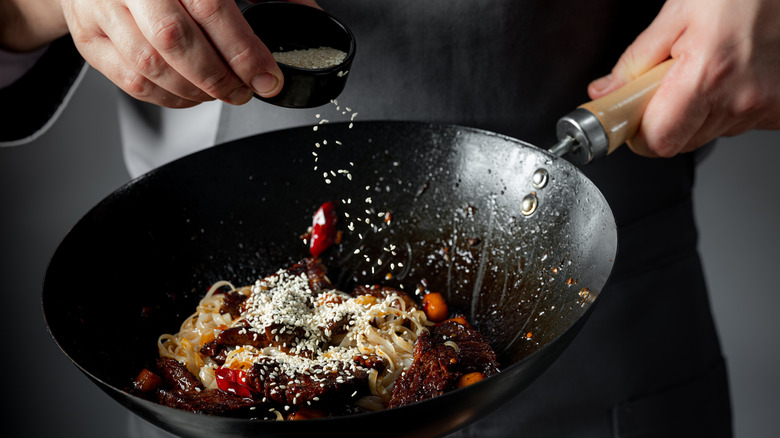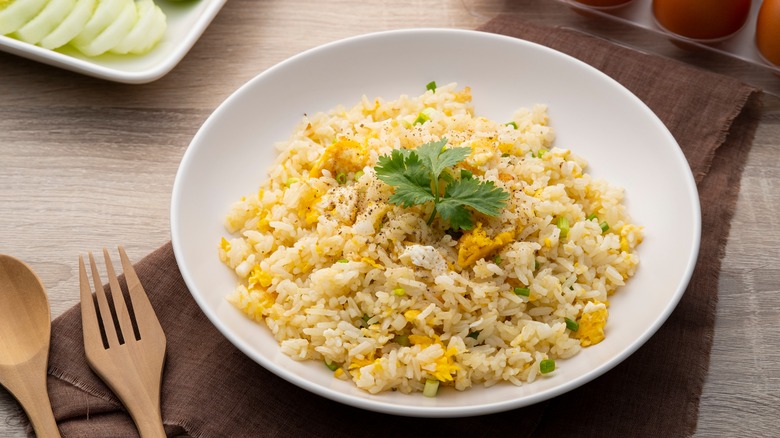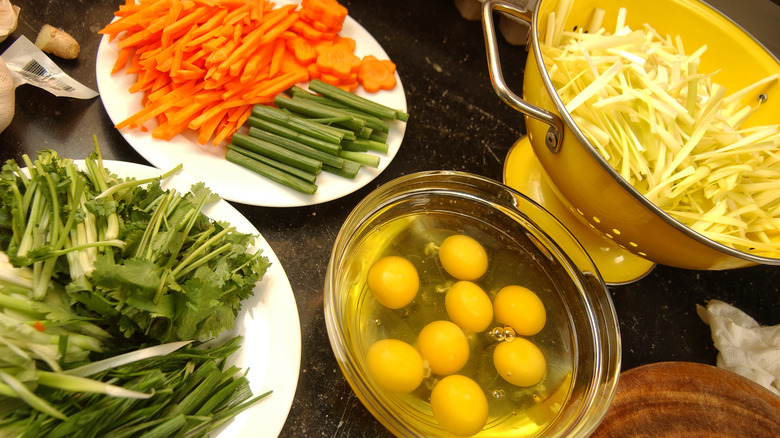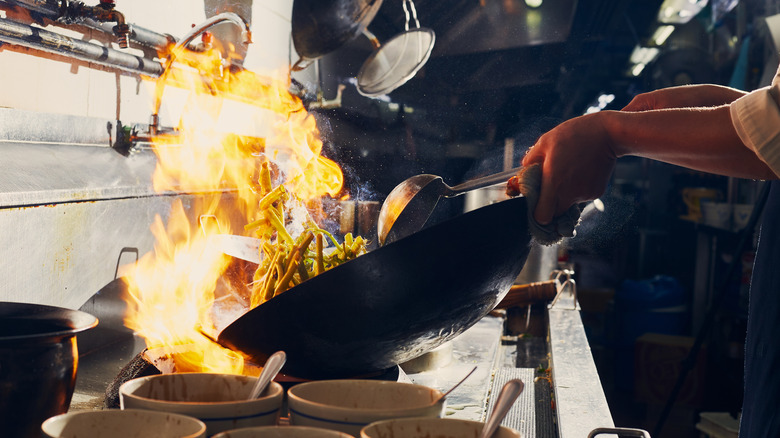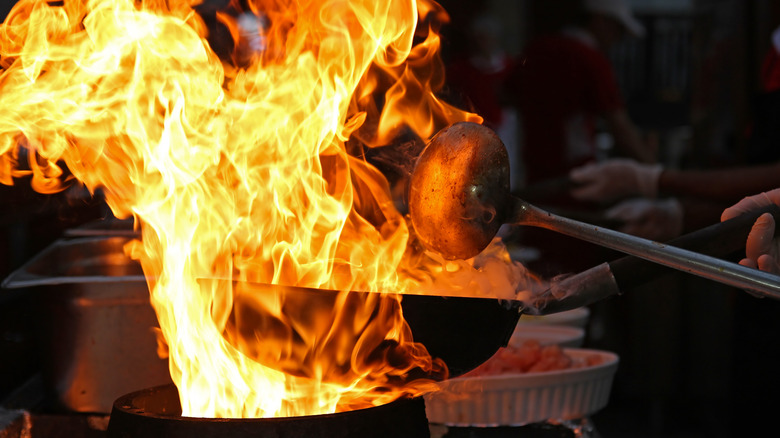What Really Makes Takeout Fried Rice So Delicious
There aren't many dishes that can be made from basic staples quite like fried rice. Although cultures around the world eat rice and create fried versions of it, most people typically associate the takeout hero with Chinese cuisine. With that said, the dish can feature just about anything, from shrimp to beef to carrots to tomatoes to curry powder — which makes it a popular option for cleaning out the refrigerator.
As long as you have the following elements — rice, proteins, veggies, seasonings, aromatics, and garnishes — it should be pretty easy to replicate your favorite takeout version, right? Wrong. If you've ever attempted to make fried rice, you've probably sat there scratching your head, wondering why you can't seem to make it quite as delectable as your favorite takeout version. Although it may seem simple from the outside, there's a reason why takeout fried rice is so delicious.
We've broken down several secrets and techniques that takeout spots utilize to help you upgrade your meal in the comfort of your own home. Keep reading to learn more.
Takeout spots use the right type of rice
Despite what you may think, most restaurants that make your favorite fried rice don't use fancy, expensive rice. You can head right down to your local grocery store and pick up a standard bag of long-grain white rice to make the dish. However, restaurants still make a point of choosing the appropriate type of rice.
First off, they almost always use long-grain or medium-grain rice. Long-grain rice (like Basmati) retains distinct grains, while medium-grain has a greater chewiness and maintains its structure after frying. Cooks almost never use short-grain rice because it's a lot starchier and stickier than the other choices. Because it masses together when frying, it doesn't produce the right results.
With that said, many of the best Chinese restaurants use a combination of American long-grain and medium-grain Thai Jasmine rice to create the perfect texture. On its own, long-grain rice can be a bit bland while jasmine rice is a bit too delicate for the aggressive frying technique. Together, the two create the right blend of texture, flavor, and aroma to make award-winning rice. Luckily, there are brands like Mahatma that already sell the blend of the two kinds of rice so you don't have to combine them yourself.
Takeout rice is prepped for optimal texture
The first step to obtaining the crisp-yet-fluffy texture that every person craves is to wash the rice. First, it is important to remove any impurities like sand or husks. Additionally, rinsing gets rid of the extra starch, which is what causes grains to stick together during the frying process. If you want the individual caramelized grains that make this dish so delicious, be sure to rinse first.
However, it's possible to overdo it. It's important to get rid of the starch without over-hydrating the rice, which can result in mushy and un-caramelized grains. This also means using the right ratio of water for cooking (usually between one to one or one to one and a half of rice to water).
This is why many people agree that using leftovers is a fantastic option for fried rice. Leftover rice is much drier than the fresh stuff, which allows it to cook well with the other ingredients. However, Michelin star chef Ang Song Kang recommends always bringing the rice back up to room temperature before cooking: "It should be barely warm or at least room temperature when you start cooking, otherwise it won't be able to absorb the flavors from frying. It'll be a wasted effort."
Another trick to getting your old rice ready for frying is to spread it out over a large plate or baking sheet uncovered. This ensures that each grain will dry out individually without locking the moisture in.
The best Chinese restaurants use the right kind of soy sauce
Not all soy sauces are created equal. When making fried rice, your favorite takeout restaurant doesn't just grab any old bottle of soy sauce and throw it into the dish. There are many types of soy sauces from different cultures, and each one has a distinct profile that looks, tastes, and even feels unique.
This is why nailing the right one is the key to obtaining that takeout-style taste. For example, if you use a Japanese soy sauce like Kikkoman, you'll get a result that won't really match that authentic Chinese takeout taste. The four brands most Chinese restaurants use are Lee Kum Kee, Koon Chun, Pearl River Bridge, and Kimlan. These are readily available in most areas and are preferred by restaurants for their distinct flavors. However, it's important to note that these soy sauces get categorized into light and dark.
Although the name is misleading, light soy sauce doesn't mean it has a lower level of sodium content. It's simply the standard soy sauce used for flavoring and seasoning. However, it doesn't provide a deep color like dark soy sauce. The latter is mainly used for coloring and doesn't add much saltiness and flavor — it is actually a bit sweet. Restaurants always make sure to have both light and dark versions to nail that complex, savory flavor.
The secret weapon is tenderizing the protein correctly
To make chicken fried rice, most restaurants use breast meat. The problem (as most home cooks probably know) is that chicken breast is very lean, which means it can dry out really quickly. But whenever you bite into a piece of chicken, beef, or other meats from a Chinese restaurant, you've probably noticed that they are always incredibly tender and juicy. This isn't a coincidence.
There's a secret tenderizing ingredient that your favorite takeout restaurant uses every single time: baking soda. Baking soda neutralizes the acids, raising the pH level of the meat. This in turn alkalizes the meat's surface, which makes it harder for the proteins to bond together, resulting in super tender meat. This means that even the leanest cuts of meat come out juicier than most people are used to when they cook at home.
Chinese restaurant chefs use about a teaspoon of baking soda and massage it into the protein they are cooking. After letting it sit for a few minutes, they move on to marinate the meat, which adds flavor and can also improve the texture.
This trick is often referred to as "velveting." It is commonly used for beef and chicken, but can even be used for more delicate meats like fish and shellfish. It's also a great way to make cheaper, secondary cuts of meat much more delicious.
Restaurants often rinse the chicken
Food safety experts — look away from this one. Another strategy Chinese takeout restaurants use is to thoroughly wash the chicken with cold running water, squeezing out the excess. Although this might sound counterintuitive in Western cuisine, there are several reasons why this is done.
As J. Kenji López-Alt explains in an episode of Milk Street Radio, this process helps tenderize the meat even further, and even gives it "a sort of slickness." This helps the meat better absorb the flavors of the marinade and combine with the other ingredients like vegetables. It also hydrates it so that it remains crisp and juicy, even when cooked over incredibly high temperatures.
However, it's important to keep in mind that water doesn't actually get rid of bacteria like Campylobacter or Salmonella that live on raw meat. In fact, the USDA Food Safety and Inspection Service reports that rinsing meat can backfire, causing bacteria to spread and cross-contaminate other surfaces.
Chefs cook with high-quality woks and powerful heat
If there's one essential ingredient in a bowl of fried rice that sets the takeout stuff apart, it's "wok hei" — also known as "the breath of the wok." The concept was introduced to Western eaters in the 1980s when Grace Young referred to the phrase in her book "The Wisdom of the Chinese Kitchen: Classic Family Recipes for Celebration and Healing." In the book, she writes, "Wok hei is not simply hot food; it's that elusive seared taste that only lasts for a minute or two," (via CNN).
Basically, it's the irreplaceable, steaming-hot aroma and taste that can only be created at the highest temperatures with a wok. Chinese restaurants have high-quality woks and commercial-grade burners that allow them to cook at high heat. This helps create the Maillard reaction — a chemical reaction that browns the food and unlocks new levels of flavor and aroma. By cooking at wildly hot temperatures with a wok, Chinese chefs are able to harness the Maillard reaction and wok hei in a short amount of time, creating a powerful result that can't be imitated.
Of all the techniques that professional chefs use, this one might be the hardest to replicate at home. However, there are certain tricks that you can do to imitate the smokiness, such as adding toasted sesame oil to garnish your final dish.
Restaurants love MSG, the misunderstood flavor bomb
Monosodium glutamate, aka MSG — one of the most delicious yet misunderstood ingredients out there. It's a white, odorless powder that enhances the flavor of dishes by adding a satisfying umami taste. So why does it have such a bad reputation?
In the 1960s, a doctor wrote a letter to the New England Journal of Medicine noting that he got sick after eating at a Chinese restaurant. He went on to say that the culprit was either alcohol, sodium, or MSG. This created a wave of backlash and misinformation not only against the ingredient but also against Chinese immigrants and their cuisine. After decades of controversy, several highly respected health authorities including the Food and Drug Administration (FDA) and the European Food Safety Association (EFSA) all deem MSG to be safe for consumption.
The truth is, MSG is a fantastic flavor enhancer — and Chinese restaurants know it. It provides way more flavor while only containing a third of the sodium of table salt. It activates the taste receptors on your tongue by packing an umami blast of savoriness with every bite. Ultimately, you get a long-lasting aftertaste that seems to coat your palate, similar to Parmesan cheese or a rich chicken broth.
The best takeout spots use the perfect combination of sauces and seasonings
When it comes to the best takeout fried rice, restaurants always build a powerful combination of aromatics and seasonings. To begin, they'll use a foundation that includes garlic, shallot, ginger, scallions, onion, and chili peppers. These ingredients infuse flavor into the oil and transport it to every other ingredient in the wok.
When it comes to seasonings, people who attempt to cook fried rice at home often make the mistake of drowning it in soy sauce, resulting in a salty, mushy mess by the end. In reality, restaurants use a combination of light and dark soy sauce, as well as a sweet element like sugar to balance everything out. They use the right amount to flavor the dish while keeping the rice dry enough to caramelize.
Speaking of caramelization, another technique restaurants use is to pour the sauce around the side of the wok rather than directly on top of the ingredients. This allows the liquids to sear independently, resulting in the intense, smoky, "wok hei" flavor of fried rice. At the same time, it helps the wok maintain a consistent temperature to avoid steaming the ingredients. Getting that browned soy sauce flavor from the edge of the wok significantly contributes to that addictive, takeout taste.
Cooks never underestimate the power of the all-important egg
It's no secret that eggs make pretty much everything better. Although there are hundreds, maybe thousands of different iterations of fried rice, you'll typically find egg included in most. Besides the obvious purpose of adding delicious and nutritious protein to the dish, they play a more important role in the dish as well.
According to two different Michelin star chefs, the egg mixture added to the fried rice coats every single grain of rice to give them a beautiful golden hue that "resembles an auspicious 'mound of gold.'" It is said that the golden fried rice was popularized by Emperor Yang Guang of the Sui Dynasty (A.D. 569 to 618) who adored the dish more than any others when visiting Yangzhou.
It may seem like a relatively unimportant ingredient in the dish compared to the rice, veggies, seasonings, and aromatics, but that's far from the truth. No matter how it is utilized, it adds a delicious richness and color that can't be replaced.
Restaurants always have every ingredient ready to go
If you've ever tried to improve your cooking technique, you've probably heard of "mise en place." For the uninitiated, it means having all of your ingredients and dishes prepared and ready to go before you begin cooking. It literally translates to "everything in its place." Although it's important for cooking in general, it's especially important for fried rice.
The process of cooking fried rice goes by lightning fast. If restaurants don't have everything they need while cooking over a volcano-sized flame and a heavy wok, the ingredients will burn up and quickly go to waste. This means that cooks chop, measure, and set apart every single ingredient they need before service because there's literally no time during the cooking process to prep more ingredients. Once they get going, chefs can handle the wok and flame while throwing in ingredients like it's second nature.
Takeout spots usually cook everything together
You've probably seen videos of expert chefs maneuvering heavy woks over powerful flames with ease, masterfully tossing in ingredient after ingredient until a beautiful, steaming dish seems to appear out of thin air. They truly create the essence of what a one-pot meal should be.
But it's important to note that these master chefs can only do this because of the wok and the extremely high temperatures their burners reach (not to mention their years of experience). Chinese restaurants have special wok stoves that seem to have the power of a jet engine when shooting out a flame. To put this into perspective, most Chinese restaurants have wok burners that reach well over 100,000 BTUs, which is about 10 times as hot as the typical stove you find in homes. They also have round openings that cradle the wok perfectly.
If you're trying to replicate it at home, chances are you'll need to cook all of the ingredients separately in order to make sure you cook them through properly. Cooking food in small batches ensures every ingredient is just right, bringing you closer to the inimitable flavor of takeout fried rice.
Restaurants always finish the dish with powerful flavor enhancers
The best takeout restaurants always make sure to finish off with powerful flavor enhancers that take the dish to the next level. One ubiquitous ingredient in Chinese cuisine is Shaoxing wine. This rice wine is a key ingredient when it comes to creating that authentic takeout flavor. When added to fried rice (and other Chinese dishes), it infuses depth, flavor, and hints of acidity and sweetness. It's used near the end of the cooking process to deglaze the fried rice but it is essential for brightening the dish and tying the flavors together.
Another great ingredient used to finish fried rice is toasted sesame oil. It brings an incredibly fragrant, nutty flavor that further enhances the complexity of the dish. The smokiness is a great additive and substitute for the wok hei that comes from the powerful burners and woks of a Chinese restaurant. These ingredients bring additional complexity to the dish that takes it to the next level.
